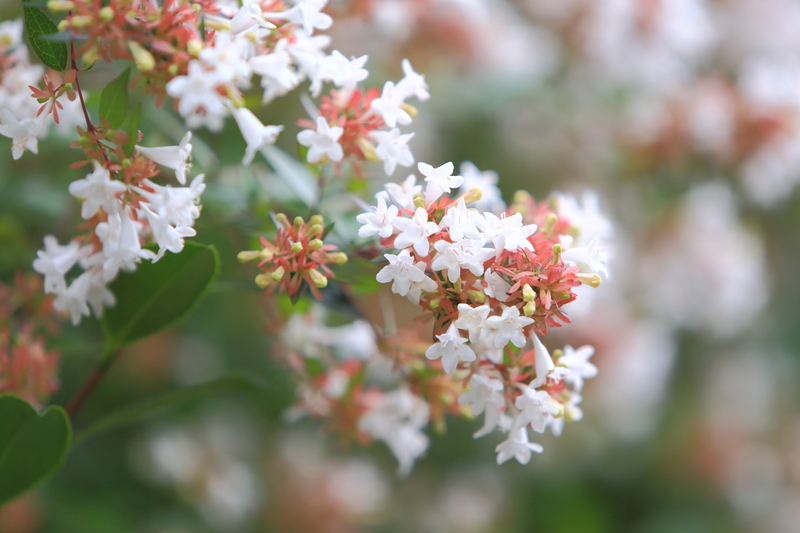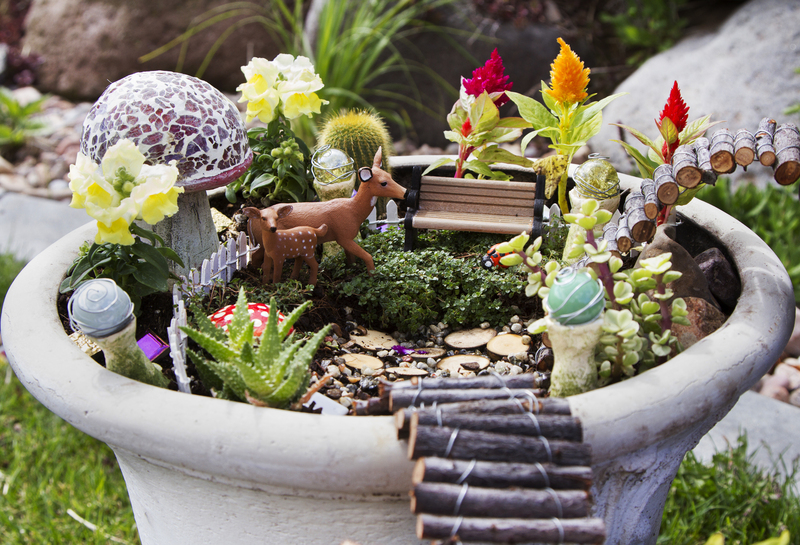Make Your Garden a Haven with Perfectly Designed Seating Areas
Posted on 11/09/2025
Make Your Garden a Haven with Perfectly Designed Seating Areas
Your garden can be much more than a collection of plants and shrubs. Transforming your outdoor sanctuary with skillfully designed seating areas will elevate not just the beauty, but also the comfort and functionality of your green space. Whether you envision a cozy nook for quiet reflection or an elegant zone for entertaining, wonderfully planned garden seating can turn any yard into a personalized retreat. Read on for practical advice, creative ideas, and design inspiration for making your garden a haven with perfectly designed seating areas.
Why Focus on Garden Seating?
Seating areas are more than just places to sit. They offer opportunities for:
- Enjoying nature -- Watch butterflies, listen to birds, or savor your morning coffee surrounded by greenery.
- Socializing -- Host friends and family in a welcoming, open-air lounge.
- Relaxation -- Meditate, read, or simply unwind after a long day.
- Functional beauty -- Enhance the structure and aesthetics of your landscape design.
By incorporating inviting garden seating, you bring true purpose and comfort to your outdoor space, making it a natural extension of your home.

Types of Garden Seating Areas
There are countless options to craft the ideal garden seating zone. The best choice depends on your garden size, style, uses, and your personal preferences. Here are some popular variations:
1. The Classic Patio Lounge
A garden patio is a timeless choice for relaxing and entertaining. Whether stone, brick, or wood, a patio provides a stable, level surface for furniture. Add a table, comfy chairs or a sectional sofa, and perhaps a fire pit or heater for year-round coziness. Enhance with potted plants and soft outdoor rugs for added texture and warmth.
2. Tranquil Corner Benches
Benches nestled into quiet corners create perfect nooks for contemplation or reading. Position your bench beneath a flowering tree or near a fragrant border. For privacy, surround your seating with shrubs or tall grasses. Consider built-in stone or wooden benches for a custom look, or easily moveable options for flexibility.
3. Pergolas and Gazebos
Covered seating areas such as pergolas, gazebos, or arbors provide shelter and define a garden room. Decorate the structure with climbing roses, wisteria, or grape vines. Furnish with outdoor sofas, chairs, or a swing for ultimate comfort. This option is ideal for enjoying your space even in less-than-perfect weather.
4. Dining Spaces
A table surrounded by chairs turns your garden into an al fresco dining destination. Choose materials that withstand the elements, like metal, teak, or treated wicker. String lights, lanterns, or candles amplify the atmosphere, helping create memorable meals in your outdoor haven.
5. Swing Seats and Hammocks
For instant relaxation, add a swing seat or hammock to your garden. Hang from sturdy trees or a dedicated frame and scatter with soft cushions and throws. These options encourage gentle movement, perfect for both children and adults to unwind.
Design Tips for Creating the Perfect Outdoor Retreat
Making your garden seating area perfect isn't just about furniture placement -- it's about creating a harmonious environment that looks good and feels right. Consider these essential design elements:
1. Planning and Positioning
- Sunlight and shade: Notice the sun's movement across your yard. Place seating in a spot with ideal light for the times you intend to use it.
- Views: Orient seats to face your most attractive garden features--flower beds, water features, sculptures, or open lawns.
- Privacy: Position seats away from sightlines to neighboring properties. Use tall plants, trellises, or privacy screens as needed.
2. Size and Scale
- Choose furniture proportionate to your space--a sprawling sectional may overwhelm a small courtyard, while tiny bistro chairs can be lost in a large yard.
- If you need flexibility, opt for foldable or stackable pieces and modular seating arrangements.
3. Comfort and Durability
- Invest in weather-resistant materials such as treated wood, metal, polypropylene, or resin wicker.
- Layer with washable, fade-resistant cushions and throws for all-season comfort. Store soft furnishings inside in harsh weather if needed.
- Make guests feel welcome with benches and seating options that include armrests and backs for extra support.
4. Integrating with Landscaping
- Soft boundaries: Edge seating areas with well-chosen plants--aromatic herbs, colorful perennials, or ornamental grasses help blend structures with the landscape.
- Natural elements: Use rocks, logs, or boulders for organic, sculptural seating that feels like a natural part of the garden.
- Paths and access: Connect your seating with winding paths, using gravel, stepping stones, or mown grass for inviting, easy access.
5. Personalization and Style
- Add personality with cushions in bold colors or unique patterns.
- Include accessories such as lanterns, planters, outdoor art, or wind chimes to reflect your taste.
- Upgrade ambience with soft lighting--overhead fairy lights, ground lanterns, or solar-powered fixtures work wonders after dark.
Creative Ideas for Unique Garden Seating Areas
Garden seating design is your chance to get creative. Here are some unique ideas to make your garden truly stand out:
- Fire Pit Circles: Arrange curved benches or chairs around a central fire pit--perfect for evening gatherings and toasting marshmallows.
- Hidden Sanctuary: Create a secret spot screened by tall shrubs or trellises, furnished with a single cushioned bench or small bistro set.
- Under-Tree Oasis: Place a hammock or love seat beneath mature trees for dappled shade on hot afternoons.
- Water Feature Lounging: Set seating beside a small pond, fountain, or stream for the soothing sound of running water.
- Sunken Patios: Level out a small area below garden grade for a secluded, protected seating zone, adding steps and retaining walls for a unique look.
- Playful Pods: Use round or cocoon-shaped seats for sheltered reading, relaxing, or stargazing. These sculptural elements make a fun focal point.
Choosing the Right Materials for Garden Seating
Material choice is crucial for both durability and aesthetics in your seating area. Let's examine some top options:
Wood
- Classic and warm, blends seamlessly into natural surroundings.
- Look for hardwoods like teak, acacia, or eucalyptus for resistance to weather and decay.
- Regular sealing or oiling may be required to maintain appearance.
Metal
- Wrought iron and powder-coated aluminum offer strength and intricate styling.
- Powder-coated finishes resist rust and come in many colors.
- Cushion for comfort and to prevent heat or cold transfer.
Stone and Concrete
- Permanent and virtually weatherproof; ideal for built-in benches or more formal gardens.
- Can be dressed up with removable cushions.
- Provides great structure and visual weight in larger landscapes.
Resin and Synthetic Wicker
- Lightweight and easy to move while being weather-resistant.
- Modern options closely resemble natural materials.
- Require minimal upkeep--just wipe clean or hose down.
Maximizing Small Gardens with Smart Seating Solutions
If you have a compact garden or limited space, you can still create a perfect outdoor retreat with clever seating ideas:
- Foldable or stackable seating: Store out of sight when not in use.
- Corner benches: Make use of otherwise wasted corners and add built-in storage underneath for cushions or tools.
- Wall-mounted seats: Attach flip-down seats to boundary walls or fences for instant space-saving seating.
- Multi-purpose furniture: Choose benches that double as planters or garden storage boxes.
- Bistro sets: Small table and chair sets that can tuck into any nook or balcony for quick refreshment breaks.
Adding the Finishing Touches: Accessories and Decoration
It's the thoughtful finishing touches that turn a standard garden seating area into a true haven. Consider incorporating:
- Outdoor cushions and throws: Add luxurious comfort and a burst of color.
- Weather-resistant rugs: Define seating zones and add texture underfoot.
- Planters and flower pots: Fill with fragrant blooms, grasses, or even edibles for beauty and usefulness.
- Lighting: Install solar lanterns, fairy lights, or LED path markers for magical evenings outdoors.
- Side tables: Handy for drinks, books, or snacks--choose sturdy materials that match your main furniture.
Maintaining Your Garden Seating Area
A well-maintained seating area strengthens your garden's inviting atmosphere. Here's how to keep your outdoor retreat looking its best year-round:
- Clean furniture and cushions regularly--brush off dirt, wipe down surfaces, and wash covers as directed.
- Check for signs of wear, rust, or rot and treat as necessary to extend lifespan.
- Store cushions, throws, or delicate accessories in a waterproof outdoor box or shed in winter.
- Renew painted or stained surfaces periodically to protect against weathering.
- Prune surrounding plants to prevent overgrowth and maintain accessibility and views.

Frequently Asked Questions: Creating the Perfect Garden Seating Haven
How do I choose the best spot for a seating area in my garden?
Consider sunlight, views, and privacy. Place seats where you'll enjoy natural light at your preferred time of day and have good sightlines to attractive features, while also making sure you're sheltered from wind and onlookers.
What style of seating area suits a modern garden?
Opt for sleek, minimalist furniture in neutral or bold hues. Use geometric lines, metal, and glass, and keep the design uncluttered. Built-in benches or low loungers complement contemporary gardens beautifully.
Can I have a seating area in a very small garden?
Absolutely! Use foldable bistro sets, built-in corner benches, or creative wall-mounted solutions even in the tiniest spaces. Choose multi-use furniture to make the most of every inch.
What plants work best around seating areas?
Go for aromatic herbs (lavender, rosemary), low-maintenance grasses, colorful flowering perennials, and small shrubs that won't overcrowd or block access. Consider container gardening for flexibility.
How important is lighting in a garden seating area?
Lighting is essential for both safety and ambiance. Use solar stakes, fairy lights, or lanterns to define the area, highlight plants, and ensure you can use your garden retreat after sundown.
Conclusion: Enjoy Your Perfectly Designed Garden Seating Haven
Creating a perfectly designed garden seating area is one of the most rewarding ways to add new life, beauty, and function to your outdoor space. With thoughtful planning, the right materials, and a dash of personal style, your garden can truly become a haven--an enchanting outdoor room where you relax, socialize, and connect with nature. Start today and transform your garden into a sanctuary you'll cherish for years to come!

